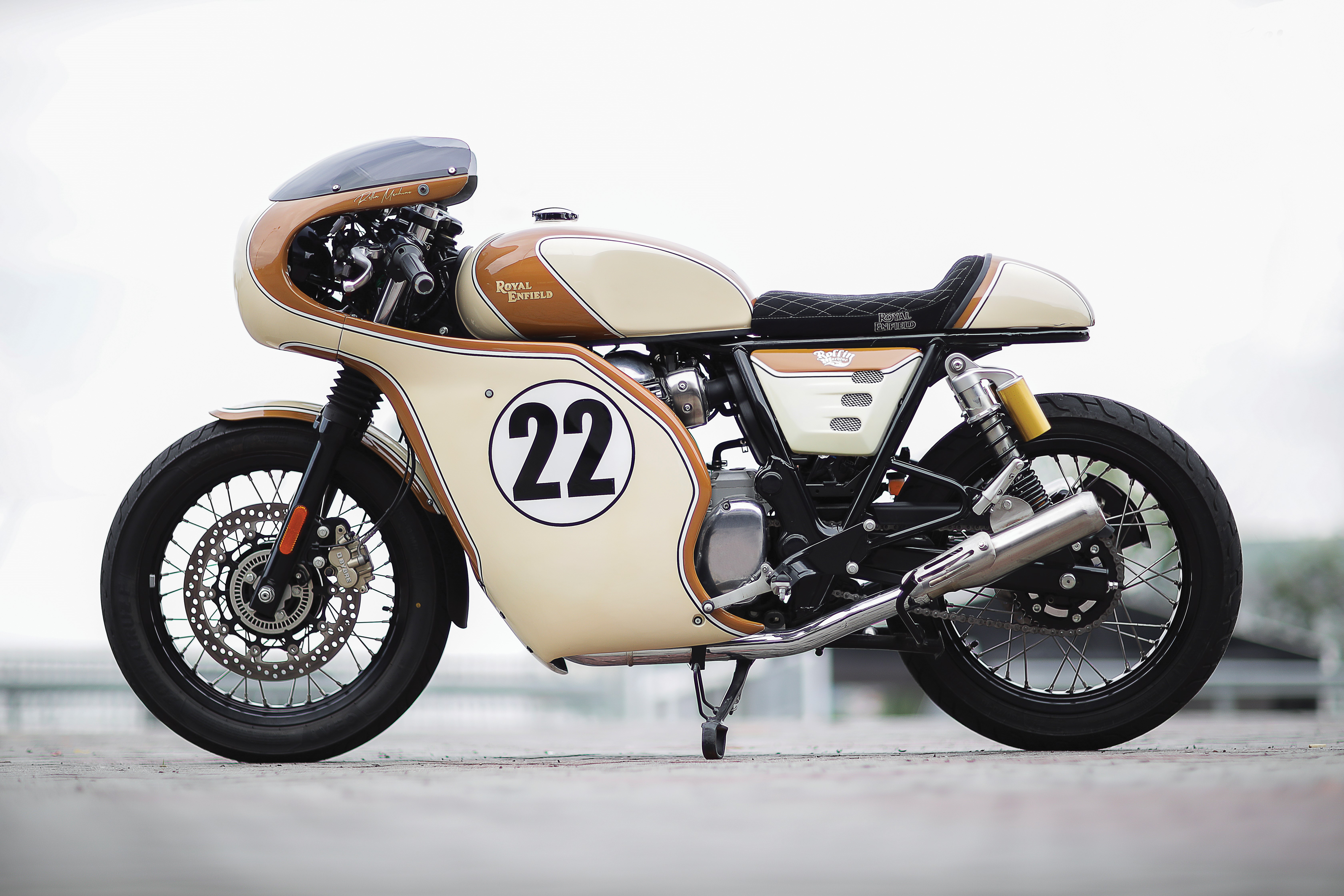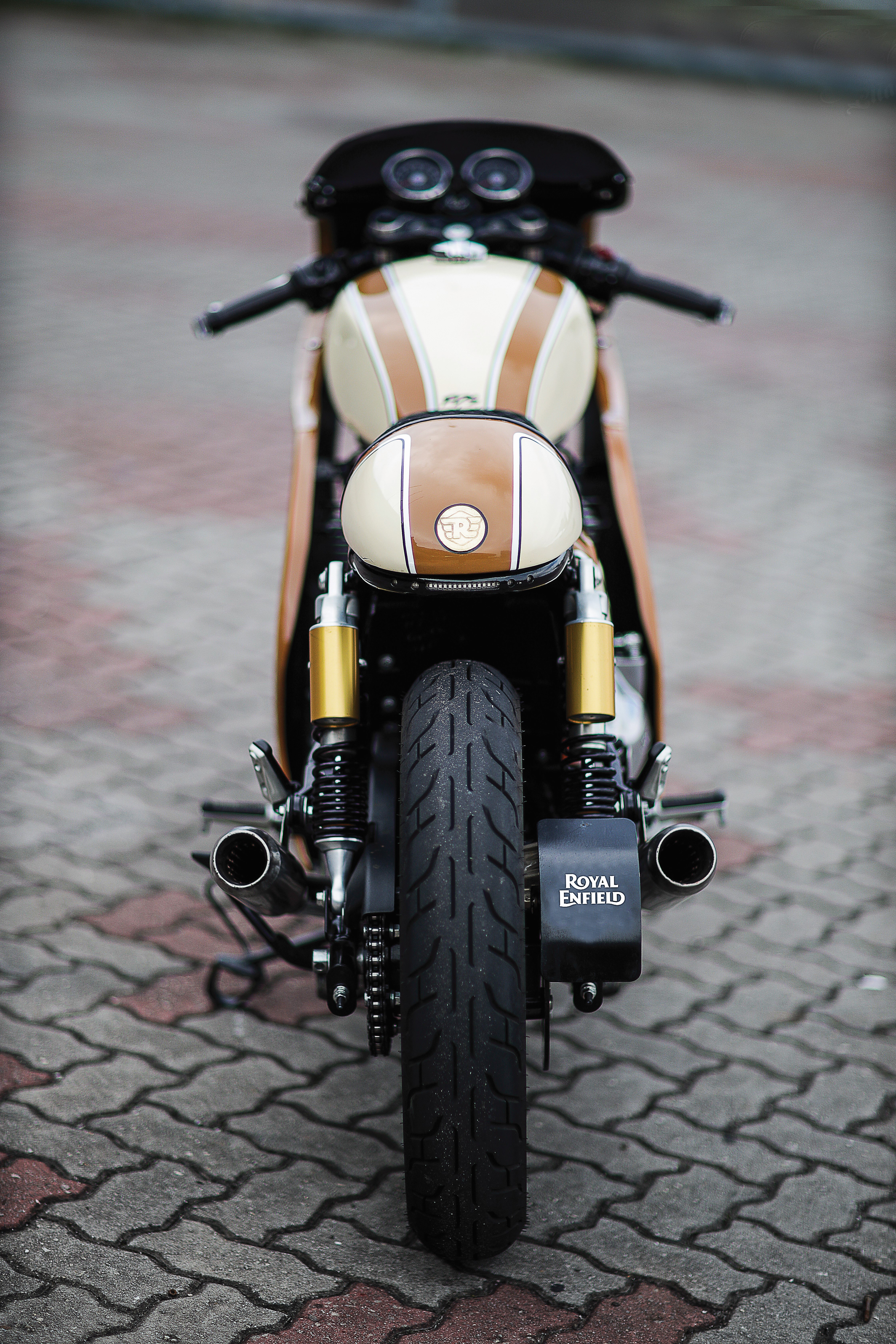The Rollin Machine Interceptor Honors A Classic British Bike
“It’s like riding with no hassle, just pure steel.”

The story of Royal Enfield is a wild and circuitous one. In the 1950s and ’60s the British manufacturer was the preferred choice of café racers and gentlemen rogues who made that era in motorcycling one of the most influential ever.
But like most British marques from the 20th century, Royal Enfield struggled to compete with cheaper—and regrettably more reliable—Japanese bikes that poured into Europe and America in the, ’60s and, ’70s, eventually leading to the company’s shuttering in 1971.
Except it didn’t, really. Across the globe in one of the British Empire’s former colonies, Royal Enfield had planted a seed that survives to this day. You see, in 1954 the government of India commissioned a huge order for Royal Enfield’s Bullet model to supply its troops along the Himalayan border with longtime rival Pakistan.
This is where the highest roads on the planet exist, at celestial low-oxygen altitudes that test even the best engines. For this reason, India hand-picked the Bullet as its chosen steed because of the single-cylinder, stamped-steel bike’s ability to function reliably at these incredibly high altitudes, where the engines of most other motorcycles failed to operate consistently.
To build the Bullets at volume while minimizing costs, Royal Enfield licensed their badge and engineering to a factory in India, where the Bullet has been steadily produced ever since—making it the longest continuously produced motorcycle model on the planet.

And which today brings us to Kuala Lumpur, Malaysia, where one Bobby Fuego has taken the form of a modern Royal Enfield Interceptor and elevated it to the next level. Or rather, time-warped it into the past. The career photographer/videographer made waves recently with his Rollin Machine Interceptor, tapping his social media skills to ripple his creation from the remote Malaysian city to the centers of cultural chic worldwide. He then uses the reaction and clout his bikes receive to gauge if a design was successful.
More than a decade ago, Fuego’s first two-wheeled creation was a scooter he personalized with a slick custom paint job, loaded with speakers and other fun accessories. “The main objective was I wanted my bike to look different from others, outstanding with cool design,” Fuego tells us about catching the builder bug.
“That’s where it came from, the idea of customization.” The young craftsman wasn’t alone in Kuala Lumpur. He shares how the classic bike scene has exploded among the capital’s youth. While on trend, Fuego laments that many still might lack knowledge about the history, culture, guidelines and parameters of the international custom bike scene.
“That’s [when] I decided in 2016 that I wanted to share my enthusiasm with others, so I launched the brand of Rollin Machine. At first it was just a bunch of riders wearing leather jackets, riding classic/custom bikes, taking pictures, just doing the video scene,” Fuego explains. “But with the rise in demand of custom bikes, we got set up and decided to do custom builds for others.”
Now after a pandemic-induced sabbatical, Rollin Machine rises once again with this winsome, impeccably crafted ode to retro Grand Prix racing. And while Fuego namechecks other brands Rollin Machine likes to customize, including Triumph, Moto Guzzi and Harley-Davidson, there are reasons why Royal Enfield stands out from the crowd. In fact, the attraction blossomed when Royal Enfield first hired him for a freelance photo and video job in 2021.
“The thing with Royal Enfield is its simplicity of pure motorcycling. With the design, not much modern technology, the price, tough build, durability—it amazes me right away,” the Malaysian customizer continues. “It’s like riding with no hassle, just pure steel. And that’s what I want: to have a bike that goes for simplicity, yet powerful and with a tough-looking engine.”
As for the Interceptor, what struck Fuego first over Enfield’s other models like the Continental GT was its gas tank. With its clean geometric shape, the Malaysian customizer could instantly see how the fairing should flow. “That’s the reason why I choose the Interceptor: it is one of a kind.”
While the young builder had a vision for the Interceptor since 2021, Royal Enfield gave him a heads up that an updated model was coming in 2023, with a new LED headlamp, panel indicator, aluminum switch cube, gas-charged twin shock and more. So Fuego waited until this past August and bought the 650cc parallel twin-cylinder model as soon as he could. “More than enough for me,” he admits.

Obviously the most salient component of the build is the fairing, which Fuego admits was the most difficult part to construct, taking more than three weeks. Initially aiming to craft the piece from steel or aluminum, he soon discovered carbon fiber was a superior solution, as Rollin Machine could sculpt a mold and then quickly and easily stamp more fairings.
Other highlights include the diamond-stitch Alcantara seat with embroidered Royal Enfield logo, bookended by a carbon fiber seat cowl. Then there’s the handmade racing-style muffler, built from scratch to improve both performance and aesthetics. Lastly the livery: beige and brown for a retro styling, then gold leaf for the logo, and black and white for the racing number, all hand brushed.
“The main goal is to make it look like it’s racing on the track, a true retro GP racer,” Fuego shares proudly. “I studied and researched a lot about the bikes from that era, just to get the vibes perfectly suited for the style.”
This article originally appeared in the May/June 2024 issue of Maxim magazine.
